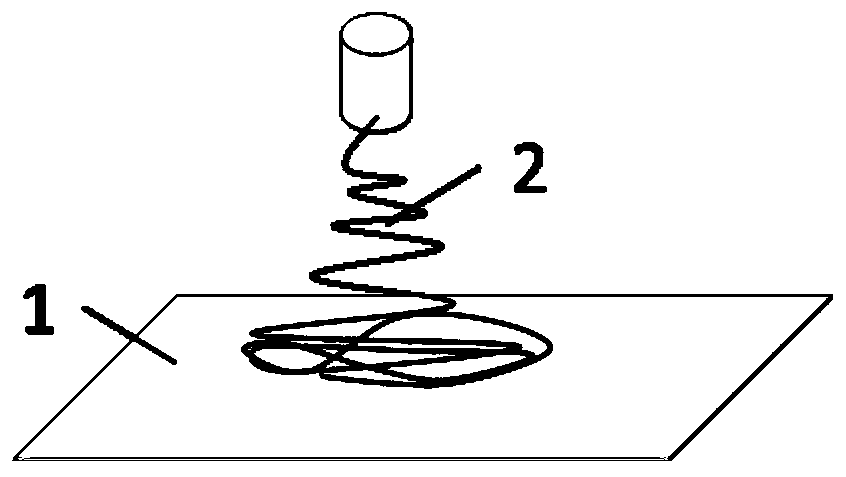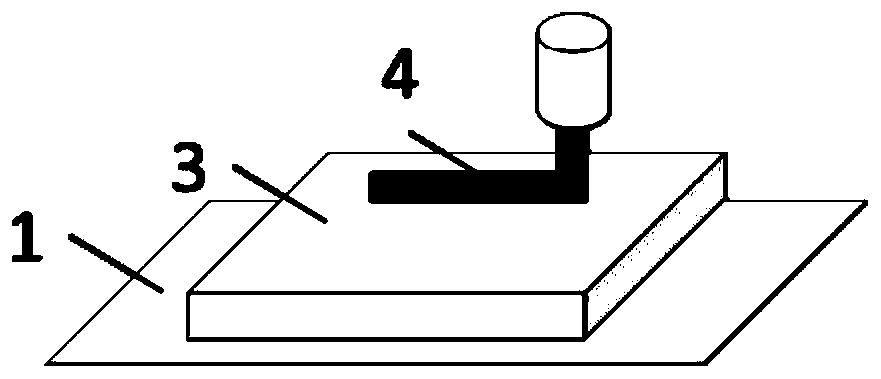Near field direct writing focusing and micro pattern separation method based on PEO electrospinning film substrate
An electrospinning direct writing and micropattern technology, applied in the field of electrospinning direct writing, can solve the problems of difficulty in removing the electrospinning direct writing micropattern from the substrate, jet whipping, etc.
- Summary
- Abstract
- Description
- Claims
- Application Information
AI Technical Summary
Problems solved by technology
Method used
Image
Examples
Embodiment 1
[0028] refer to Figure 1-Figure 5 As shown, this embodiment utilizes the high porosity and water-solubility properties of the PEO fiber membrane to realize the focusing of the electrospinning direct-writing jet and the non-destructive detachment of the micropattern of the poorly water-soluble material. The near-field direct writing focusing and micropattern detachment method based on the PEO electrospun membrane substrate includes the following steps:
[0029] 1. Material selection
[0030] In this example, the target material is polyvinylidene fluoride (PVDF), the isolation sacrificial material is polyethylene oxide (PEO), the collecting substrate is tinfoil paper, and the solution used for separation is deionized water H 2 O; choose the mixed liquid of DMF and acetone as the solvent of PVDF, choose alcohol and deionized water as the solvent of PEO. Among them, polyvinylidene fluoride is a polymer material that is difficult to dissolve in water, and it will not deform grea...
Embodiment 2
[0043] The basic process of this embodiment is the same as that of Embodiment 1, the difference is:
[0044] Prepare 100mL of 6wt% PVDF solution, the ratio of NMP to acetone in the solvent is 5:5, the steps are: measure 50mL of NMP, then weigh 5.785g of PVDF powder, add it to the aforementioned liquid, then measure 50mL of acetone, and pour it into the aforementioned liquid Finally, magnetic particles were added to the mixture, and stirred under a magnetic field for 12 hours to fully mix the components.
[0045] Among them, corresponding to different solution concentrations, the ratio of NMP to acetone in the solvent can be arbitrarily selected in the range of 2:8 to 8:2 to change the solvent volatilization rate, thereby controlling the fiber morphology.
Embodiment 3
[0047] The basic process of this embodiment is the same as that of Embodiment 1, the difference is:
[0048] Prepare 100mL of 20wt% PVDF solution, the ratio of NMP to acetone in the solvent is 5:5, the steps are: measure 50mL of NMP, then weigh 22.656g of PVDF powder, add to the aforementioned liquid, then measure 50mL of acetone, pour into the aforementioned liquid Finally, magnetic particles were added to the mixture, and stirred under a magnetic field for 12 hours to fully mix the components.
[0049] Among them, corresponding to different solution concentrations, the ratio of NMP to acetone in the solvent can be arbitrarily selected in the range of 2:8 to 8:2 to change the solvent volatilization rate, thereby controlling the fiber morphology.
PUM
 Login to View More
Login to View More Abstract
Description
Claims
Application Information
 Login to View More
Login to View More - R&D
- Intellectual Property
- Life Sciences
- Materials
- Tech Scout
- Unparalleled Data Quality
- Higher Quality Content
- 60% Fewer Hallucinations
Browse by: Latest US Patents, China's latest patents, Technical Efficacy Thesaurus, Application Domain, Technology Topic, Popular Technical Reports.
© 2025 PatSnap. All rights reserved.Legal|Privacy policy|Modern Slavery Act Transparency Statement|Sitemap|About US| Contact US: help@patsnap.com



